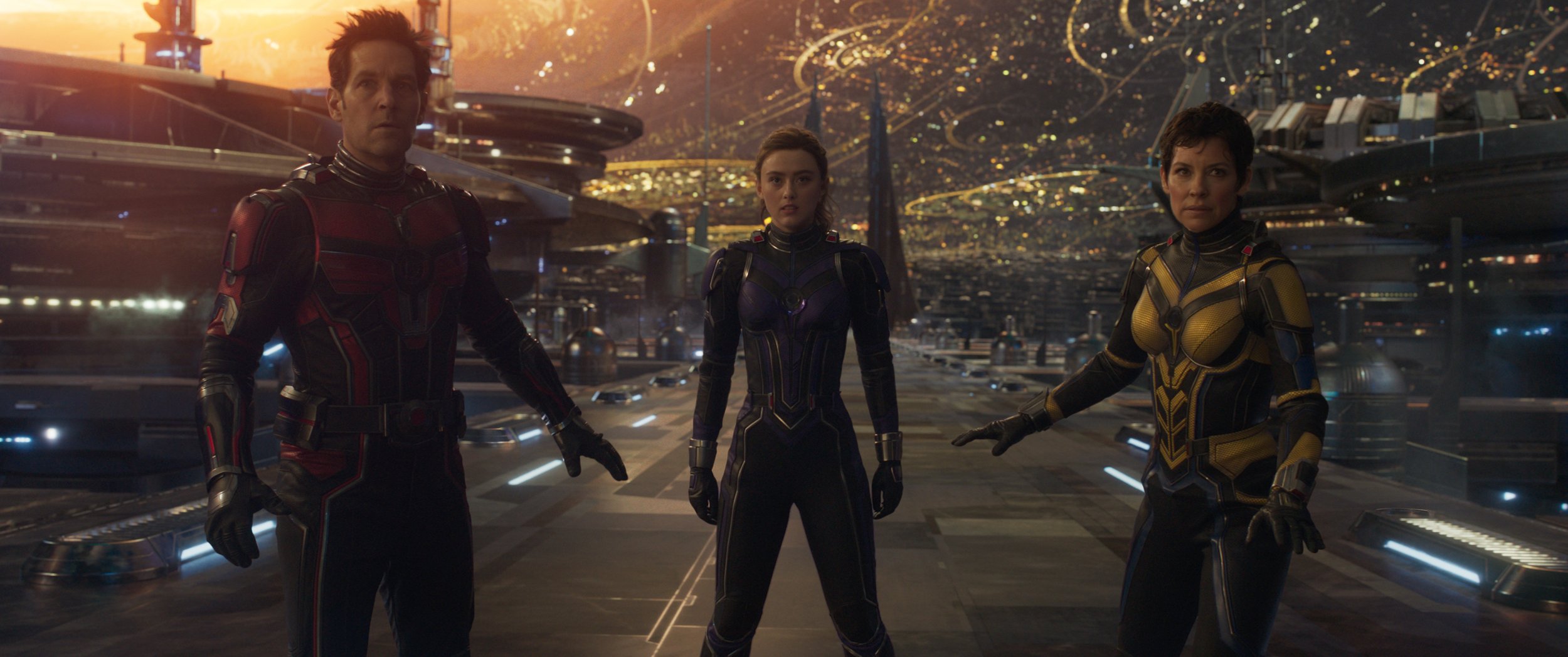‘Ant-Man and The Wasp: Quantumania’ Review: If ‘Spy Kids’ and ‘Star Wars’ Were Part of the MCU
Ant-Man and The Wasp: Quantumania is a solid start to—yet another—new phase in the MCU. With the events of Loki lurking in the background, Quantumania gives Jonathan Majors’ Kang the Conqueror another eleventh-hour reveal as Scott Lang (Paul Rudd) and his family are unexpectedly pulled into the Quantum Realm.
While family is still the heart and soul of Peyton Reed’s third Ant-Man film, Quantumania breaks from tradition and delivers a decidedly Star Wars-infused story, complete with alien-filled cantinas, sand speeders, and the sort of “rise against our oppressor” messaging that is often lost within the Marvel Cinematic Universe. Likewise, if you grew up loving the Spy Kids movies, then there’s every chance that you will love what Quantumania is putting down with its villainous designs and comedic beats. Everything from the design of MODOK (Corey Stoll) to the heroic ants to the jokes about holes and dicks and the central focus on family—it screams mid-aughts in the best of ways. This blend of narrative influence and visual design makes Quantumania one of the better films to arrive since the start of Phase Four.
Image via Marvel Studios
Majors was already a stand-out performer from Marvel’s Phase Four, after his magnetic performance in the final act of Loki, but Quantumania allowed him to explore another side of the many, many Kangs that exist within the multiverse. This Kang is decidedly duplicitous as he plays upon the sympathies of Janet van Dyne (Michelle Pfeiffer) as a lost soul, all the while planning to become a cruel, tyrannical ruler. The contrast between these two personas is sharp and tantalizing to watch unfold. This Kang is so casually cruel and calculated in every way, and Majors’ performance lures you in with practiced ease, making you want to root for him even though he is, without a doubt, a true villain.
Pfeiffer is another powerhouse in Quantumania, which shouldn’t actually come as a surprise. While Cassie Lang (Kathryn Newton) may be the reason why their family ends up trapped in the Quantum Realm, Janet is the reason why the Quantum Realm is in such disarray. The film opens on a flashback to when Janet was stuck in the Quantum Realm for thirty years and reveals that she saved Kang’s life when his ship crash-landed there, but it takes almost the entirety of the first two acts to return to this flashback and explore what really happened. What is revealed could have benefited from longer scenes, rather than the cliff notes version presented. In this case, brevity is not the soul of wit—especially not when Majors and Pfeiffer are electric on screen together, acting circles around each other, and outshining almost all of their co-stars. Even Michael Douglas and Bill Murray.
Image via Marvel Studios
The film may be titled Ant-Man and the Wasp, but Ant-Man and the Wasp (Evangeline Lily) often feel like background characters in their own film, and that’s not necessarily a bad thing. Rudd is still largely front-and-center, especially as he’s fighting to save his daughter’s life from Kang, but Cassie eclipses both of them as the most interesting character. Cassie is cut from the exact same cloth as her father, though she hasn’t been changed by Avengers-level heroics or book deals. She is focused on helping the less fortunate, even if that means getting thrown into jail—both in the real world and the Quantum Realm. Her plotline and evolution as a hero in her own right will likely leave audiences jonesing to see her team up with the other under-30 Marvel heroines like Yelena (Florence Pugh), Kate (Hailee Steinfeld), Kamala (Iman Vellani), America (Xochitl Gomez) and Maya (Alaqua Cox).
Despite the current critical response of Ant-Man and The Wasp: Quantumania, it’s not actually a bad movie and it’s far from becoming the worst film they have ever put out. The plot line is tighter and far more cohesive than The Eternals, and it was able to create well-rounded characters, despite having a crowded cast list. The out-of-this-world visuals of the Quantum Realm are eye-catching and fun, and genuinely some of the best CGI and VFX work since the start of Phase Four. It isn’t a visual slog like the cacophony of Doctor Strange in the Multiverse of Madness, and it doesn’t treat its female characters as over-emotional menaces who are unworthy of agency. Quantumania leaves you feeling excited, hopeful, and energized about where Phase Five is headed—especially if it means Kang is going to be at the forefront of the chaos that’s yet to come.
Ant-Man and The Wasp: Quantumania is one of the best MCU films in recent history because it doesn’t take itself so seriously. It delivers fun, light-hearted, and sometimes juvenile humor all the while delivering weighty plotlines and exceptional performances. While Paul Rudd will always be Ant-Man, the final chapter in his trilogy sets the stage for Cassie Lang to eclipse him as a superhero to rally around. Despite its minor structural issues—which is owed to the fact that it holds back a hand that the audience already knows is at play—Quantumania seizes on an aspect of comic book storytelling that is often overlooked in a world filled with grimdark tales: fun.
Don’t let the naysayers keep you from indulging in two hours of dorky jokes, heartwarming family bonding, and Jonathan Majors acting circles around everyone.
FINAL VERDICT: B-



